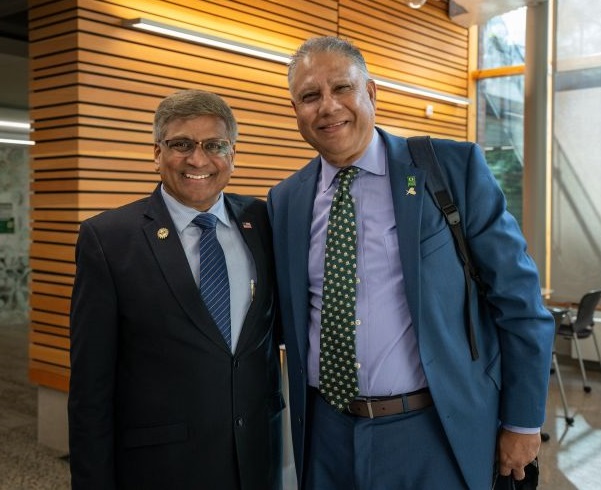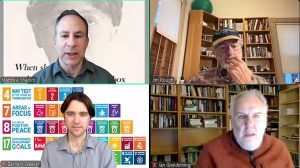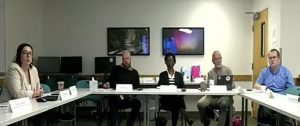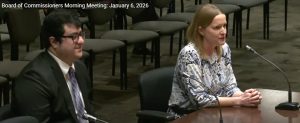NSF Director ‘Panch’ praises UO research programs, partnerships with community colleges
10 min read
The director of the National Science Foundation, Dr. Sethuraman Panchanathan, visited the University of Oregon over the summer.
President Karl Scholz: This is the first time that an NSF director has visited Eugene and the University of Oregon. So Director Panchanathan, on behalf of the University of Oregon, welcome, and we are most grateful for your visit.
[00:00:23] Many of our key aspirations align with NSF priorities and NSF-supported research, led by UO faculty and students. NSF investments help UO scholars, to give just one example, address some of the most pressing societal challenges.
[00:00:41] The Cascadia Region Earthquake Science Center (CRESCENT), is the first major research and education center to study the Cascadia subduction zone and the nation’s first subduction zone earthquake hazard center. The $15 million that the NSF awarded to establish CRESCENT is important in helping to understand where we live and the associated hazards.
[00:01:09] One of our strongest commitments at the University of Oregon is to accelerate scientific impact. I’m particularly excited about our partnership with the two-year colleges, our collaborators in the NSF-funded Oregon Pathways to Industry Research Careers program. I’d like to thank two presidents, Rachel Pokrandt, the president of Umpqua Community College, and Stephanie Bulger, the Lane Community College. And I want to express a specific note of gratitude to our colleagues from Intel, from Oregon State University and Portland State University.
[00:01:54] Anshuman Razdan (Vice president for Research and Innovation): As President Scholz noted, this is first-ever visit by a National Science Foundation director and indeed a momentous occasion for all of us.
[00:02:04] Just for historical context, if some folks may not know about NSF, NSF came into being in 1950 after World War II as need for an agency to support basic science and engineering to ensure long-term prosperity and security of United States by investing and fueling innovation in the U.S. universities.
[00:02:28] So NSF, like NIH (National Institutes of Health), is one of the only two agencies that supports basic science research. Next year, NSF celebrates 75th year, and I had to say that without leaders like the director, who are not only pushing the depths of the disciplines, but across disciplines, NSF and the United States would not be the leader in science and engineering throughout the world, as it is today.
[00:02:58] So it is now my great honor and tremendous pride as a fellow Indian and as someone full of Oregon joy (remember folks, joy is not just in Minnesota) to introduce Dr. Sethuraman Panchanathan. From students to presidents and prime ministers across the world, he’s known by ‘Panch.’ So that’s how we’re going to address him. So welcome, Panch.
[00:03:25] He’s the 15th director of National Science Foundation. I’m not going to repeat what is in the bio. Instead, I want to introduce him in a little more personal way.
[00:03:36] As a former junior colleague, as a fellow computer science researcher and a faculty, and someone who knows him a little more intimately than many of you that are gathered here, we’re going to take a trip back to 1997, Arizona State University Computer Science Department. There was a buzz about this new faculty, new professor who was an expert in AI and multimedia joining us from Ottawa and ‘interdisciplinarity’ was the new word phrase in many of the funding agencies like NSF.
[00:04:15] There was a call for interdisciplinary proposals. We submitted, jointly submitted a proposal, about $500,000, which had anthropologists and a professor of sculpture. That proposal was roundly rejected. And I quote, the summary comment was, ‘This proposal is too interdisciplinary. When we said interdisciplinary, we meant hardware engineers talking to database people.’
[00:04:47] Dr. Sethuraman Panchanathan (NSF director): One of the things I’ve learned since coming to NSF is NSF seems to be the best-kept secret. It has done unbelievable work. And oftentimes, it is known to a few academics. I know there’s an academic audience principally.
[00:05:03] Even here, I will tell you, not much is known about NSF except through the windows that people see NSF through. ‘I’m a material scientist, I know something about NSF.’ ‘I’m a soil scientist, I know something about NSF.’ But not the comprehensive picture of what NSF is and what it was envisioned to be.
[00:05:20] Seventy-five years ago, this unbelievable scientist, Vannevar Bush at MIT, wrote an amazing treatment as we came out of World War II. He wrote this amazing treatment called, ‘Science the Endless Frontier.’ And he said to then-President Roosevelt, he said, ‘Mr. President, we are coming out of World War II. We have done amazing discoveries and inventions like radar and other things that will impact humanity into the future. But we need to continue that level of intensity and intentionality so that we might continue to make that progress moving into the future.’
[00:05:57] And so this treatment that he wrote was to develop an agency that is focused on curiosity-driven, discovery-based research and use inspired solutions-focused research. All of that being put together so that our nation may continue to be in the vanguard of unleashing prosperity for everyone, not only in our nation, but all across the globe, in every facet of what we need to do. And he set forth this amazing mission statement.
[00:06:26] Folks, remember that this was written 75 years ago. I would not change one word of this mission statement. If that is a testament to the unbelievable ingenuity of Vannevar Bush and what he set forth in terms of building this unbelievable agency—
[00:06:45] This was in 1945 when he wrote this treatment, ‘Science the Endless Frontier.’ Five years later, by an act of Congress in 1950, NSF was established, signed by President Truman and that’s this agency, the agency that is responsible for the progress of science, advancing national health, prosperity and welfare, and of course securing the national defense, economic security, national security, prosperity and ensuring that we are solving real problems for real people everywhere.
[00:07:13] And that doesn’t impact globally by what we do here. And that’s the agency. When I came to the agency, therefore, I said, what are the things that I would like to see that NSF emphasized? What I call strengthening at speed and scale. This is the moment that calls for us to strengthen at speed and scale.
[00:07:33] So when I came to NSF, I said, this legacy of 75 years of unbelievable progress has to continue at speed and scale. And that should absolutely be the case because that’s what the nation needs. That’s what the globe needs. And if we’re strengthening the established NSF, it’s something that should be an imperative. It is like they are not walking away from anything, but you’re doubling down, tripling down on everything. But then what is missing?
[00:08:02] What is missing is a central piece of what we want to accomplish. And what is that? That is to ensure that there are the opportunities. As I say, talent and ideas are democratized and they are everywhere across our nation. Tell me if it is not rural or urban, across the broad socioeconomic demographic, across the rich diversity of our nation, talent and ideas are democratized. But guess what? Opportunity is not democratized.
[00:08:28] This is an unacceptable future for any nation, particularly for a nation like the United States, which is leading the world.
[00:08:35] And therefore, how do we ensure that those missing millions of people who are to be brought into this talent spectrum, how is it that we do that with intentionality and intensity? And this is a very important imperative: Making sure that we’re doing everything to ensure that all institutions are successful.
[00:08:54] (UO Vice President Anshuman Razdan) AR talked about the fact that I’ve come to Oregon. Let me tell you. Let me tell you why I said yes right away. I want to go to those institutions where the NSF directors have not gone. I have not been at Stanford, Harvard, MIT, Berkeley. I’ve not been there, nothing wrong. But those institutions where the NSF director goes or not will do amazing work. But I want to celebrate the work in those institutions where typically where people don’t go to celebrate those work.
[00:09:22] And I want to make sure that the land community colleges and the unbelievable community colleges in this environment here represented by the leaders are celebrated or recognized because that’s what it takes for our nation to be in the vanguard of innovation. In addition to the unbelievable work done by MITs and Stanfords and Harvards, of course, they’re a phenomenon. We need them, but we need a lot more too. And therefore, the inspiring, the missing millions is a significant central mission of how NSF needs to move forward in the future.
[00:09:48] The president just talked about this amazing project called CRESCENT. CRESCENT is a project of how do you invest in preparedness, preparedness against things such as earthquakes, natural hazards. These are a huge problem these days in our nation. How do we invest in these ideas early enough that we might be able to prepare ourselves in these kinds of hazard situations, natural or manmade? And how do we do that?
[00:10:15] Right here, right here at Oregon, there’s a unique facet, a unique facet of what you’re looking at, which is what the president talked about: Subduction zone earthquake hazard. It is not like it is a replicant of something else somewhere else. It’s a unique facet of that, that is very attuned to the local nature of what Oregon is.
[00:10:33] Innovation is everywhere. It is in context. That’s all. You have to make sure that we mind that context that is best suited for that place. What is best for this place? Clearly, semiconductors. No question about that. Right? Clearly, mass timber. Nobody questions, ‘Why not Oregon?’ isn’t it. So there are these topical areas where Oregon can be the leader, a national leader in terms of not only building the future, training the workforce, building unbelievable innovation ecosystems.
[00:11:02] Let’s take another example. The Center for Materials Characterization in Oregon called CAMCOR. I’m going to go visit this center next in my itinerary. I am so excited to see what’s going on. We have invested in this program of CAMCOR and electron microscopy. As you know, understanding and characterizing materials, developing new materials, this is a very, very important thing as much as computing is important, materials are also important, the future of materials.
[00:11:28] And so right here in terms of polymer characterization, as well as X-ray analysis of understanding the materials composition, how do we build new materials are exceedingly important as you think about the future.
[00:11:37] John Q: The director said the NSF has been a longtime supporter of research in computing and artificial intelligence.
[00:11:44] Dr. Sethuraman Panchanathan (NSF director): How many of you know that Google as a company, the two founders, Larry Page and Sergey Brin, were graduate research fellows of NSF? They wrote a proposal in 1994 to NSF to say that we want a digital libraries project funded. NSF funded that. Five years later in 1999, they wrote the final report and they said, ‘By the way, we founded a company called Google a year earlier in ‘98,’ and the rest is a trillion-dollar history. People do not know how thousands and thousands and thousands of companies have their DNA of NSF, whether it is through the inventors, discoverers and the workforce and the leadership.
[00:12:28] NSF has been investing in AI for over six decades. When the term AI was just barely being pushed into the agenda, machine learning barely coming into the fore, NSF has been investing year after year after year, decade after decade after decade, even during AI winters when people were skeptical about AI, NSF continued to invest. And this is what NSF does really well, is never give up, never give up because failures are always steppingstones to success. We all know that, but NSF is an agency that believes in that, not to walk away from a project when it has a failure, but to invest continuously in the concept to see what we can do even better.
[00:13:08] John Q: He’s pushing to democratize AI.
[00:13:10] Dr. Sethuraman Panchanathan (NSF director): AI progress cannot be limited to those institutions which have the wherewithal in terms of the resources available for them to advance those ideas. If we go that way, it will be a few companies and a few institutions at best who can move forward with this kind of a future. We need to democratize the access.
[00:13:27] John Q: He also wants to see more institutions supported by the NSF.
[00:13:33] Dr. Sethuraman Panchanathan (NSF director): When I came to NSF, I asked the following question. Why is it? Why is it that our portfolio of projects that we fund are primarily funding the usual suspect institutions only? ASU, University of Oregon: Why is it that only they get funded? Why not the Lane Community College? Why not the research to institutions? Why not the minority-serving institutions? What is essentially the missing piece there?
[00:13:59] The answer is very simple. It is that you need a dedicated office that helps faculty find opportunities, forms teams, help them write proposals and with graphics, nobody can beat them. Small institutions cannot afford that. They don’t have the capacity to do it. It’s a downward spiral. If I don’t win proposals, there’s no way I can have resources to set up an office. So we said, we have to break this cycle.
[00:14:23] How can we democratize this access? The ideas are there. How do we ensure those ideas do get the support to ensure this access is obtained?
[00:14:31] John Q: He sees bipartisan support for basic science in both houses of Congress. Still, he encouraged researchers to share stories about the impact of their work.
[00:14:40] Dr. Sethuraman Panchanathan (NSF director): Let me tell you categorically, there is total bipartisan support for what science can do for the country, economic and national security. I work with both sides of the aisle in House and Senate. I tell you there is excitement about what science can do and what science can do, particularly in the context of our competitor, China. Okay? And therefore, I can tell you right now, there is no lack of understanding that basic science discovery is important.
[00:15:04] Let’s work together to communicate the impact of science in a way that people can relate to.
[00:15:10] John Q: The first-ever visit to the University of Oregon from the director of the National Science Foundation.






